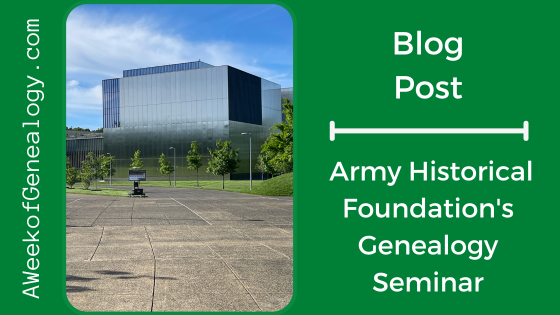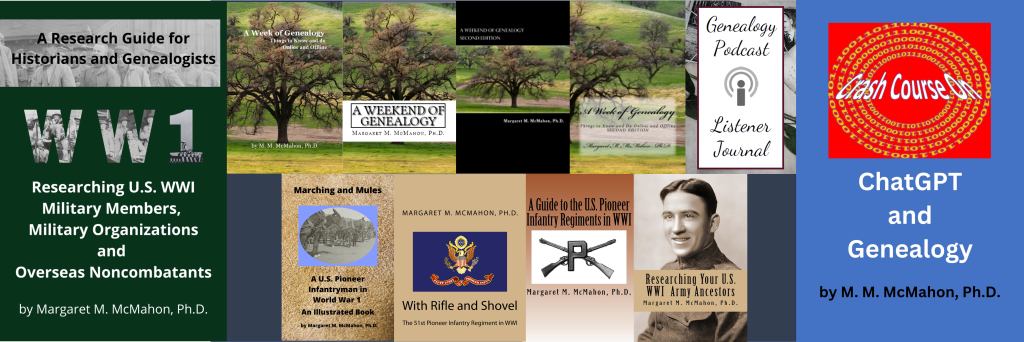Army Historical Foundation’s Genealogy Seminar

On 11 May 2024 I attended The Army Historical Foundation’s Genealogy Seminar, hosted at the National Museum of the United States Army. The seminar was entitled “Unlock your military legacy.” There were attendees both in person and online, and I was able to attend in person.
The speaker lineup was impressive: Richard G. Sayre, COL (USA-Ret.), Pamela Boyer Sayre, and Rebecca Whitman Koford, CG, CGL. Many of you know Rick and Pam from their outstanding presentations. Among her many accomplishments and extensive service to the genealogical community, Rebecca currently works as Executive Director of the Board for Certification of Genealogists® and is the Director of the Genealogical Institute on Federal Records (Gen-Fed) which is held annually at the National Archives in Washington, D.C.
Rebecca began the seminar with an excellent presentation about “Records of the U.S. Army held by the National Archives and Records Administration.” Sharing her hands-on experience, she demonstrated the types of records and how and where to locate them. Demonstrations of how to use the NARA Catalog are always beneficial. She also shared examples with us of records she had found about her ancestors.
“Map Repositories in the Washington D.C. Area” was next, and in that presentation Rick discussed more than the repositories; he explained the history of mapping in the US. It is significant to know about the maps, including who created them and their purpose. He showed what was on the maps and their usefulness for using them in the context of an ancestor’s war experience. He shared so many great examples!
After a delightful lunch, and having been inspired by the two previous presentations, I was ready for the next presentation. Pam presented “Tracking an Eighteenth or Nineteenth Century Soldier.” She showed us how to time travel using Google Earth Pro. First she demonstrating what could be done, then she explained the steps in detail for how to use those features to document your military ancestor’s life in a visual and engaging format. Not only is this a great way to share information with non-genealogists, but this is also a great technique for immersion into the context of an ancestor’s service. This is something I had been considering, and using her approach will make the task straightforward and manageable.
The last presentation was by Rick and Pam, “Learning About a Twentieth Century Soldier.” This session presented resources and brief case studies about researching the service of twentieth-century soldiers at NARA facilities. Rick and Pam decided to focus on WWI, and a follow-up presentation for learning about WWII soldiers will be recorded and distributed to attendees at a later date. After the resources were discussed, a clear methodology was presented. Of course that methodology included the use of one of my favorite tools, timelines. Rick clearly described the homework that a researcher needs to do before contacting and visiting a NARA facility.
The presentations were very practical in nature. While it is great to find out about resources and how to use them in your research, it is also important to know where and how to find them. Being able to use them and share them is also incredibly valuable. The NARA Catalog can be awkward to navigate, so insights that the speakers shared were appreciated. There are always things to learn from such distinguished genealogists.
The final presentation held a couple of surprises for me. Two of my books were listed in the bibliography for the final presentation. Of course I was delighted to be included. The real surprise is that Rick and Pam showed a slide that contained the cover of my recent book, “Researching U.S. WWI Military Members, Military Organizations and Overseas Noncombatants: A Research Guide for Historians and Genealogists” I was happy for my book to receive a shout out. (They had no idea I would be in the audience!) I was even happier to see that the Pioneer Infantry Regiments were also mentioned in the presentation. If that was not enough, I was delighted when Rick asked me unexpectedly to say a few words about the Pioneer Infantry Regiments. What a privilege, and how great to see the Pioneers’ stories being told.
This all-star line-up held an informative seminar and disseminated actionable information! Thank you!
In the next blog post I share more about my visit to the Museum after the seminars concluded.
You can find out more about these two books, and others, on this website. They are available on Amazon.
“A Guide to the U.S. Pioneer infantry Regiments in WWI”




